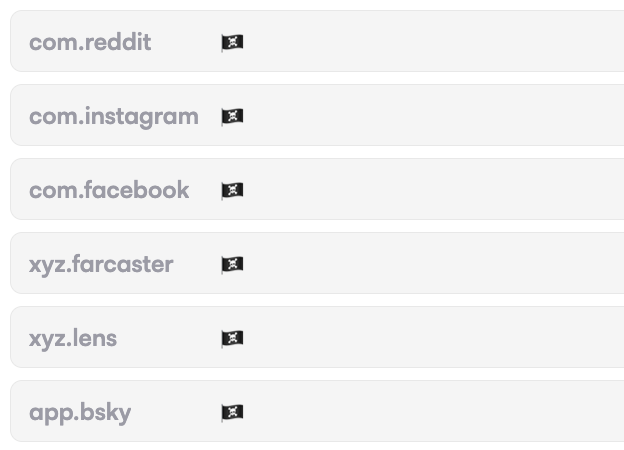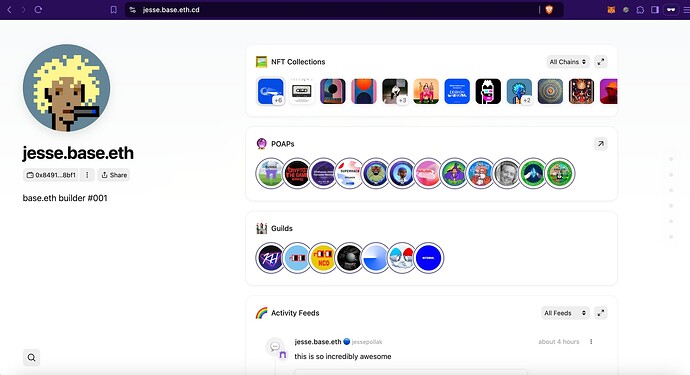eth.cd is a Web3 social networking platform that leverages Ethereum Name Service (ENS) to create dynamic, decentralized profiles based on users’ ENS records. Our platform gamifies user engagement through leaderboards and integrates social networking functionalities, such as decentralized messaging and community building, using blockchain technology.

Feature Overview: eth.cd takes a unique approach to highlighting active and engaged members of the ENS community. The homepage is ingeniously designed to showcase the top 100 profiles. This dynamic feature is not just about popularity, it’s a measure of how comprehensively users have utilized their ENS domains by adding various records. This incentivizes users to fully explore and utilize the capabilities of ENS, thereby enriching their digital presence.
Benefits for Users:
- Visibility: Being featured on the homepage increases visibility within the ENS community, offering recognition and prestige.
- Motivation for Improvement: This feature motivates users to continually update and enrich their ENS records, fostering a dynamic and engaged community.
- Discovery and Networking: It aids in the discovery of interesting profiles, potentially leading to networking and collaboration opportunities within the decentralized space.
ENS profiles
Every ENS domain represents a unique and personalized profile.
When someone navigates to hidayath.eth.cd , they will be greeted with a rich tapestry of social interactions and content. The page dynamically showcases the user’s Twitter feed, a curated list of GitHub repositories and activities, and an engaging Instagram feed, all seamlessly integrated. Additionally, visitors can preview the content of the user’s IPFS website, linked via the content hash added to their ENS. We are continually expanding our integration capabilities to ensure that each ENS profile page becomes a comprehensive hub, offering visitors a holistic view of the user’s digital presence across various platforms.
Project Description
- Objective: To create a unique, user-friendly social networking platform that offers ENS users a comprehensive digital identity, enhanced by aggregated social media content and decentralized applications.
- Features:
- ENS-Based Profiles: User profiles created with the data added to their ENS domains, which showcase their digital identity.
- Gamification: Leaderboards and rewards for users who actively update and enrich their profiles.
- Social Networking Tools: Decentralized messaging (via XMTP), following, and friend requests.
- Integration with Ethereum Follow Protocol: Allows for decentralized following functionalities.
- Content Aggregation: Aggregates content from multiple platforms based on ENS record data.
Decentralized Content Creation and Curation
- User-Generated Content: Encourage users to create content directly on the platform. This could be blogs, vlogs, or other forms of media that are then stored on IPFS.
- Decentralized Content Curation: Implement a decentralized system for content curation where the community can vote on or rate content, helping to surface quality posts.
Future Enhancements
Enhanced Communication Tools
-
Decentralized Chatrooms and Forums: Create topic-specific chatrooms or forums where users can discuss various subjects(via XMTP). These could be moderated by community-elected members.
-
Video and Voice Calling: Implement decentralized, encrypted video and voice calling capabilities for private conversations or group meetings, by integrating tools like huddle01.
-
We plan to introduce more nuanced criteria for ranking, incorporating factors like community endorsements, the creativity of profiles, and integration with other decentralized services.
Proposal for Standardizing of Records key value in ENS Domains
Currently, ENS records incorporate a limited selection of predefined keys for various social media and platforms, such as:
- “com.twitter”
- “com.discord”
- “com.github”
- “com.reddit”
- “org.telegram”
To accommodate the ever-evolving digital landscape, there’s a pressing need for a standardized format for additional social media platforms. I propose we adopt a consistent “com.” prefix for all future social media records. This approach would not only streamline the integration process but also ensure uniformity and ease of use. Suggested additions could include:
- “com.instagram”
- “com.facebook”
- “com.lens”
- “com.farcaster”
- “com.bluesky”
This standardization would be immensely beneficial for future developments and integrations. @nick.eth , your insights and guidance on this matter would be invaluable.
We would love to hear your thoughts on the following:
- New Features: Are there any specific features or integrations you would like to see on our platform?
- User Experience: How can we make your experience more seamless and engaging?
- Community Building: What tools or functionalities would you like to have to connect and interact with other users more effectively?
- Any Other Ideas: We’re open to any and all suggestions. Nothing is too big or small!




